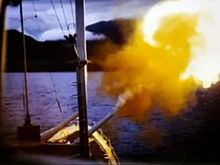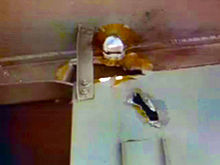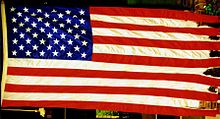- USS Hanson (DD-832)
-
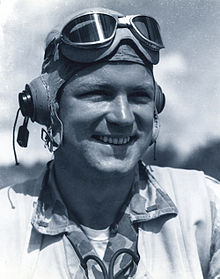 Ship's namesake, First Lieutenant Robert M. Hanson.
Ship's namesake, First Lieutenant Robert M. Hanson.
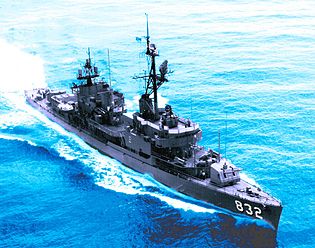
Career (United States) 
Name: USS Hanson (DD-832) Namesake: Robert M. Hanson Builder: Bath Iron Works, Bath, Maine Laid down: 7 October 1944 Launched: 11 March 1945 Commissioned: 11 May 1945 Reclassified: DDR-832, 8 March 1949 Struck: 31 March 1973 Honors and
awards:8 battle stars (Korea)
7 battle stars (Vietnam)



National Defense Service Medal

Vietnam Campaign Medal
Fate: Transferred to Republic of China, 18 April 1973 Career (Republic of China) 
Name: ROCS Liao Yang (DD-21) Acquired: 18 April 1973 Reclassified: DDG-921 Decommissioned: 1 June 2004 Fate: Sent to the bottom of the South China Sea. She is now resting as an "artificial reef". General characteristics Class and type: Gearing-class destroyer Displacement: 3,460 long tons (3,516 t) full Length: 390 ft 6 in (119.02 m) Beam: 40 ft 10 in (12.45 m) Draft: 14 ft 4 in (4.37 m) Propulsion: Geared turbines, 2 shafts, 60,000 shp (45 MW) Speed: 35 knots (65 km/h; 40 mph) Range: 4,500 nmi (8,300 km) at 20 kn (37 km/h; 23 mph) Complement: 336 Armament: • 6 × 5"/38 caliber guns
• 12 × 40 mm AA guns
• 11 × 20 mm AA guns
• 10 × 21 in (533 mm) torpedo tubes
• 6 × depth charge projectors
• 2 × depth charge tracksUSS Hanson (DD/DDR-832) was a Gearing-class destroyer of the United States Navy, named for First Lieutenant Robert M. Hanson (1920–1944), a United States Marine Corps quintuple ace who was awarded the Medal of Honor posthumously.
Hanson was launched on 11 March 1945 by the Bath Iron Works Corp., Bath, Maine; sponsored by Mrs. Harry A. Hanson, mother of Lt. Hanson; and commissioned on 11 May 1945, Commander John C. Parham in command.
 First Lieutenant Robert M. Hanson, who shot down 25 Japanese planes from the South Pacific skies, was posthumously awarded the Medal of Honor by President Franklin D. Roosevelt.
First Lieutenant Robert M. Hanson, who shot down 25 Japanese planes from the South Pacific skies, was posthumously awarded the Medal of Honor by President Franklin D. Roosevelt.
Contents
Service history
1945 – 1949
After shakedown in the Caribbean and conversion to a picket destroyer at Boston Navy Yard, Hanson sailed for the Pacific on 7 November 1945. She spent most of the following year operating in support of occupation forces in Japan, with a September period of fleet maneuvers off the China coast. Reporting to the Atlantic Fleet at the Naval Station Norfolk in Virginia on 6 February 1947, Hanson trained along the East Coast until sailing in late January 1948 for her first tour of duty with the 6th Fleet in the Mediterranean. She was designated DDR-832 (radar picket destroyer) on 8 March 1949. During her second deployment to the Mediterranean in the summer of 1949 Hanson took part in two of the most important steps toward peace taken in that tension-wracked region. As station ship to the United Nations General Assembly at the Isle of Rhodes, she was the only American warship present as Greece received control of the long-contested Dodecanese Islands. On her next important duty Hanson carried United Nations mediator Dr. Ralph Bunche, later awarded the Nobel Peace Prize, to Beirut, Lebanon, for peace negotiations on Israel.
Korea, 1950 – 1953
World crisis shifted from Europe and the Mediterranean to the East in 1950, and Hanson joined the Pacific Fleet at Pearl Harbor on 12 July to prepare for her role in the Korean War. Her first duty off the war-torn country saw Hanson participating in the amphibious operations at Inchon on 15 September 1950 as well as providing fire cover for the successful evacuation of Hŭngnam and Wonsan just before Christmas that year. Hanson's second combat cruise to Korea, September 1951 to May 1952, took her along the east coast as a member of the fleet bombarding strategic shore targets in support of ground troops where her accurate fire was most effective. In December she also participated in the important Formosa Patrol and visited Hong Kong. After a respite at San Diego, Hanson returned to the Korean bombline in December 1952 for task force operations, screening the fast carriers as they launched their jets against enemy supply lines and positions. The battle-hardened destroyer also participated in shore bombardment, search-and-rescue (SAR) operations, and Formosa patrol before returning to the United States on 20 July 1953, shortly before the end of the war in Korea.
1954 – 1964
Subsequent years found Hanson making annual six-month deployments with the 7th Fleet to strengthen American defenses in the Pacific and to prove American determination to keep the peace to possible aggressors. In addition to patrol, major portions of Hanson's Pacific cruises were devoted to tactical maneuvers and battle exercises with United States and allied ships as well as intensive antisubmarine hunter-killer training. Hong Kong, Taiwan, Japan, the Philippines, Korea, and even Australia provided familiar ports of call for the destroyer on these cruises. Hanson was patrolling the Straits of Formosa virtually within sight of Communist mainland China in the fall of 1958 as shelling of the offshore islands of Quemoy and Matsu precipitated a major international crisis. In the spring of 1962 and again in 1963 Hanson took part in the annual Australian celebration of the Battle of the Coral Sea, World War II's first carrier naval engagement in the Pacific.
When not deployed to the western Pacific, Hanson trained out of her home port, San Diego. Much of this training was centered on Hanson's role as a radar picket destroyer, designed to provide early warning of approaching enemy air, surface, or submarine forces. On 1 April 1964 she was redesignated DD-832 and entered the San Francisco Naval Shipyard to undergo a Fleet Rehabilitation and Modernization (FRAM) conversion designed to prolong her effective life as a fighting ship for many years.
Vietnam, 1965 – 1968
Conversion completed on 6 December 1964, Hanson rejoined the Pacific Fleet early in 1965 as a unit of Destroyer Squadron 11 (DesRon 11), with sister ship Dennis J. Buckley (DD-808), which was also a recent converted from DDR configuration. She operated along the West Coast until heading for the Far East early in the summer to join the fight against Communist aggression in Southeast Asia. In July she shelled enemy targets ashore and, but for brief respites, she patrolled and fought in troubled Vietnamese waters until late in the autumn.
Returning to San Diego in December, she operated along the coast of California and Mexico until getting under way for the Orient on 17 July 1966. She steamed via Hawaii, Midway, Guam, and Subic Bay for Vietnam and anchored in the Saigon River on 13 September. But for short visits to Hong Kong, Formosa, and the Philippines, Hanson operated in the fighting zone until relieved on 6 January 1967. During the deployment, her 5-inch guns fired over 9,000 rounds at Communist targets, mostly in direct support of ground forces. She also performed plane guard duty, patrolled close ashore to stop infiltration of supplies and men from the north, and refueled helicopters.
Back at San Diego on 11 February 1967, Hanson operated along the West Coast preparing for her next WestPac deployment. During the period, six months were spent in Long Beach Naval Shipyard undergoing repairs and overhaul.
Hanson's third deployment to Vietnam covered March through September, 1968. Notably, deployment was moved up in order to steam quickly to the Sea of Japan, where North Korean naval forces had recently (23 January 1968) intercepted and captured USS Pueblo in international waters off the coast of North Korea. Hanson's appearance in the area did not elicit any material response from the Communists, and after several days, the ship sailed south to join the rest of the United States 7th Fleet off Vietnam in the South China Sea. Hanson returned to San Diego in the following September.
1969 – 1971
No information available.
Vietnam, 1972
Under the command of its captain, Commander Ian M. Watson, Hanson got underway 10 April 1972 with only 3 days notice to fight the Tet offensive in Vietnam as its 7th and final tour of Vietnam service. This would also be Hanson’s final tour of duty as a U.S. Naval vessel; and it would be its most fierce wartime effort.
Arriving on station in South Vietnam 30 April 1972 with her guns blazing, Hanson received orders from CincPacFlt and proceeded to North Vietnam on 4 May 1972 for frontline combat action in Operation Freedom Train (later called "Operation Linebacker") and engaged in a series of daring raids on the Haiphong complex, which included support for Operation Pocket Money on 9 May 1972.
During Hanson’s first night of raids on Haiphong, she approached the beach at 25 to 27 knots and turned along the coast firing on enemy positions. While on her approach, Captain Watson went to the starboard wing of the bridge to use the alidade to get a bearing on Hanson’s current position. The NV guns opened up (probably 155mm with anti air rounds) and provided air burst with shrapnel, which would frequently hit the ship and puncture the upper structure. One air bursts was close to the starboard side abeam (slightly above the wing of the bridge) and knocked Captain Watson to the deck. Standing on the starboard side near the navigator's table was Tactical Communicator/JOOD, LTJG Marty Sullivan, who quickly opened the hatch and went out to check on the Captain, then assisted him to his feet. Luckily, Captain Watson had not been hit by any shrapnel and was okay. On another attack mission that same night, Hanson opened fire with star flares to illuminate targets in Haiphong, but the flares went off prematurely and only illuminated Hanson, which forced her to quickly take evasive action to avoid being annihilated by North Vietnamese guns.
 The Meritorious Unit Commendation was awarded to the crew of USS Hanson for saving the lives of American soldiers who were being overrun by enemy troops in Mộ Đức District; and its participation in a daring raid on Haiphong in 1972 during Operation Custom Tailor.
The Meritorious Unit Commendation was awarded to the crew of USS Hanson for saving the lives of American soldiers who were being overrun by enemy troops in Mộ Đức District; and its participation in a daring raid on Haiphong in 1972 during Operation Custom Tailor.
The raids continued from sunset to sunrise throughout May into June and sporadically at other times while Hanson took on fuel, supplies and ammunition during the day. The continual combat missions and replenishments kept her crew awake approximately 22 hours per day and the two hours of sleep the crew did get basically consisted of 5 or 10 minutes here and there.
On 10 May 1972, Hanson participated in Operation Custom Tailor, a history making strike that assembled the most formidable cruiser/destroyer armada in the Western Pacific since World War II. During this strike, Hanson entered the harbor and military targets within four miles of Haiphong, North Vietnam were hit, and enemy opposition was heavy. Hanson was also the last US Naval vessel to enter Haiphong harbor prior to the mining of the harbor and she was the last ship out. No other US Naval vessels entered Haiphong harbor during the remainder of the war.
During this heightened tempo of intense combat operations, hostile enemy forces fired thousands of rockets and artillery rounds at Hanson causing it to sustain battle damage from direct and shrapnel hits.
In June 1972 during night raids, Hanson dueled with North Vietnamese 155 millimeter coastal batteries near Hon La and Hon Mat islands and was hit numerous times. The shells used by the North were anti-aircraft, so most of its battle damage was shrapnel punctures to the aluminum superstructure. During one daylight raid the Hanson was struck by three Chicom (Chinese Communist) rockets with one unexploded warhead landing within a few feet of a damage control party in the main deck passageway. Miraculously, there was no loss of life aboard Hanson.
In July 1972, Hanson lost her main gyro and steering engine and put in at Subic Bay in the Philippine Islands for repairs and returned to the combat theater. It is believed the replacement parts came from another destroyer that had been damaged beyond repair by a river launched mine.
While conducting combat operations off the coast of Chu Lai on 17 September 1972, Hanson received a report indicating Mộ Đức District was being overrun by thousands of enemy troops. An Army detachment of 120 men were in Mộ Đức District] defending their position, with the help of 20th TASS FAC Air Force Captains Richard L. Poling and Joseph Personnett (reconnaissance pilots flying an armed OV-10), and desperately needed heavy artillery support to prevent its garrison from being annihilated.
Hanson was and the only gunship in the area (about 40 miles away), so it was ordered to get to the "center arena" of Mộ Đức as rapidly as possible. However, Hanson would need to travel through and past jagged coral reefs and an anti-ship mines with precision at high speed to arrive in a timely manner, which created additional danger for the ship and its crew, particularly considering her forward and aft magazines were packed with highly expolsive gunpowder and artillery rounds and that the anti-ship mines could have moved out of place during foul weather. Hanson’s only alternative would be to go around the coral reefs and anti-ship mines, which would have made the journey about 80 miles instead of 40. Even at high speed, this would have delayed her arrival to the battle zone by at least an hour and possibly result in the loss of all 120 American soldiers.
With time being of the essence, Captain Watson decided to take the short and perilous route with LTJG David Vandover as the officer in command of the bridge. Due to Hanson's timely arrival, Captain Joseph Personnett (seated behind Captain Richard L. Poling), was able to effectively direct Hanson's 5"/38 artillery rounds onto enemy troops, thus saving the lives of all 120 American soldiers.
For her timely arrival and accurate shooting in the battle for Mộ Đức District and participation in a daring raid on Haiphong during Operation Custom Tailor, Hanson’s crew received the Meritorious Unit Commendation from Admiral Elmo Zumwalt, Chief of Naval Operations on behalf of the Secretary of the Navy. Air Force Captains Richard L. Poling and Joseph Personnett were both awarded the Air Force Cross by President Richard Nixon for extraordinary heroism.
In addition to being credited for her role in saving Mộ Đức District and conducting daring raids on Haiphong, Hanson participated in surveillance and interdiction of WBLC (Waterborne Logistics Craft) barges transporting weapons and ammunition along the coastline that had been provided by a Chicom supply ship.
During the many raids on Haiphong, United States Naval Forces strategically placed several anti-ship minefields in and around the ports of Haiphong, Hon Gai, Cẩm Phả, Vinh, Quảng Khê, Đồng Hới, Thanh Hóa and other strategic locations to hinder Russian and Chinese efforts to supply enemy forces with weapons and ammunition. Having been warned to “travel at your own risk” and not being able to safely enter Haiphong Harbor, China found other ways to get supplies to the North Vietnamese Army and Viet Cong soldiers by mooring a supply ship a few yards off Vietnam’s coastline.
Since China was not officially involved with the war and had not made any direct attacks on U.S. Armed Forces, any fire power by Hanson that accidentally hit the Chicom could be regarded as an act of war against China. So Hanson steamed close by watching as the WBLC barges attempted to move away from the Chicom and hurry to the shoreline, at which time Hanson would attempt to interdict them. However, the surveillance and interdiction made Hanson an easy target, as gun emplacements near the Chicom could fire at Hanson at will, but Hanson could not return fire due to the close proximity of the enemy's guns to the Chicom, so Hanson had to continually zigzag to avoid enemy artillery.
With the Chicom having avoided the minefields, it seemed to have found a clever way to avoid the Navy's' efforts to prevent them from providing enemy forces with supplies. But Hanson's officers were a bit sharper, as it was monsoon season, which also meant “typhoon season”, and the worst place for a ship during a typhoon was being moored or in shallow water near a shoreline.
Having superior ability to monitor weather conditions and with a powerful typhoon about to hit the area, Hanson cleverly maintained her station, as if there was nothing out of the ordinary, which was to avoid alerting the Chicom of the pending storm. At the last minute without leaving time for the Chicom to deduce the situation and prepare, Hanson broke off its surveillance and interdiction heading directly into the rapidly approaching storm. Being moored in shallow water just a few yards off the shoreline while having tons of food and supplies, as well as fork lifts, cranes and other equipment on its main deck, the Chicom was violently pounded by the fierce typhoon. Suffering structural damage and having its cargo blown off its decks or washed out to sea, the Chicom retreated to China and was never seen again.
With an end to Hanson's WBLC surveillance and interdiction, she moved on to participate in other operations including plane guard for the USS Midway and combat missions in Quảng Trị Province.
On 10 November 1972, Hanson returned to San Diego for her post-deployment stand-down, an INSURV inspection and decommissioning preparation. Following the Christmas holidays, Hanson went through tender and DATC availabilities and came to her final resting place at Quaywall South Six, U.S. Naval Station, San Diego.
All told, USS Hanson spent 183 out of 214 days at sea during the April–November deployment, expended 14,486 rounds of 5"/38 ammunition, steamed 48,176 miles, burned 3,967,104 gallons of fuel and successfully completed 97 underway replenishments.
Decommissioning, 1973
Hanson was decommissioned and stricken from the Naval Vessel Register on 31 March 1973.
The ship was transferred to the Republic of China (Taiwan) on 18 April 1973. She served in the Republic of China Navy as ROCS Liao Yang (DDG-921). After 31 years of service in the Republic Of China (Taiwan) Navy, she was decommissioned on 1 June 2004 at Kaohsiung, Taiwan. In July 2006, the ROC/TW conducted a national joint armed forces Han-Kung Exercise. The Hanson participated as a target ship and was sent to the bottom of the South China Sea. She is now resting as an "artificial reef".
Awards
Hanson and the crew of the 1972 cruise were awarded the following;
 National Defense Service Medal
National Defense Service MedalSome of the above awards were awarded on previous cruises as well. No information is available on Hanson's many other awards.
References
This article includes text from the public domain Dictionary of American Naval Fighting Ships. The entries can be found here and here. [1] [2] [3] [4] [5] [6] [7] [8] [9] [10] [11] [12] [13] [14] [15] [16] [17]
- ^ http://www.usshanson832.org/ship-history.htm
- ^ http://www.navsource.org/archives/05/832.htm
- ^ http://www.history.navy.mil/library/manuscript/zumwalt_e5.htm
- ^ http://www.usshanson832.org/articles/Haiphong.htm As told by Dennis Wappes
- ^ http://www.usshanson832.org/articles/Haiphong-Run.htm As told by Bill Elliott
- ^ http://www.usshanson832.org/articles/haiphong-clip.htm 1972 newspaper article
- ^ http://www.usshanson832.org/articles/hanson-home.htm 1972 newspaper article
- ^ http://www.usshanson832.org/articles/decom.htm
- ^ http://www.airforce-magazine.com/MagazineArchive/Pages/1987/March%201987/0387valor.aspx
- ^ http://militarytimes.com/citations-medals-awards/recipient.php?recipientid=3586
- ^ http://www.navy.mil/navydata/navy_legacy_hr.asp?id=57
- ^ http://www.buzzle.com/articles/aircraft-carrier-uss-midway-cv-41.html
- ^ http://www.mesotheliomanews.com/veterans/aircraft-carriers/uss-midway-cv-41/
- ^ http://www.navysite.de/cvn/cv64history.htm
- ^ http://www.historycentral.com/navy/CVA64Constellation.html
- ^ http://www.dtic.mil/cgi-bin/GetTRDoc?AD=ADA355037&Location=U2&doc=GetTRDoc.pdf
- ^ http://www.usshanson832.org/ship-yang.htm
External links
- Photo gallery of USS Hanson at NavSource Naval History
Categories:- Gearing class destroyers of the United States Navy
- Ships built in Maine
- 1945 ships
- World War II destroyers of the United States
- Cold War destroyers of the United States
- Korean War destroyers of the United States
- Vietnam War destroyers of the United States
- Chao Yang class destroyers
Wikimedia Foundation. 2010.

